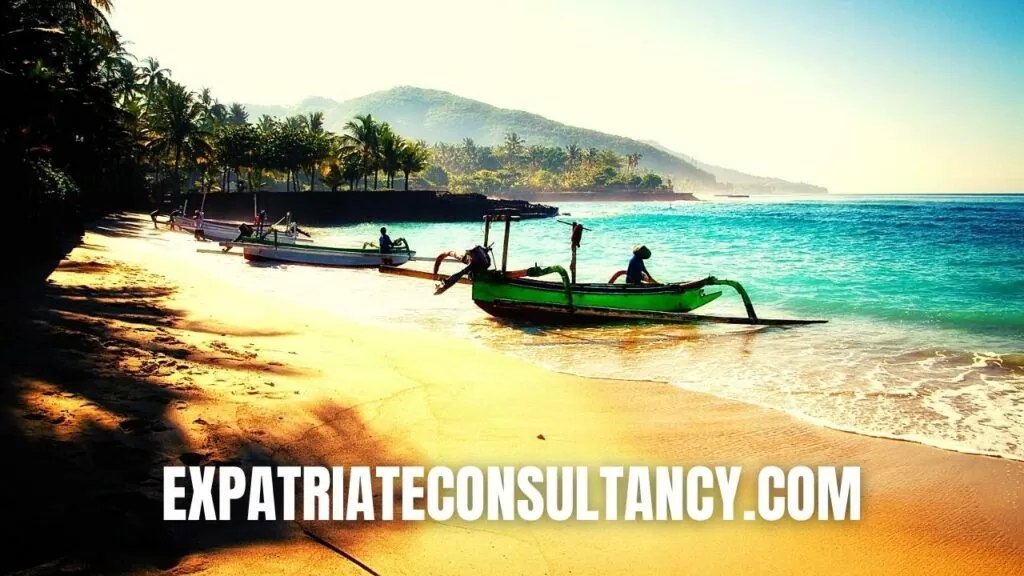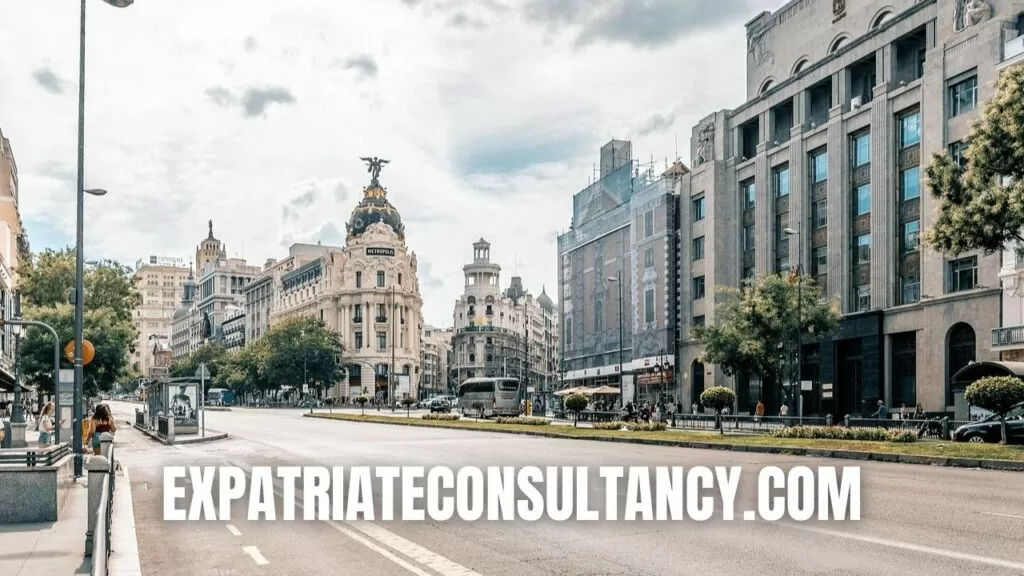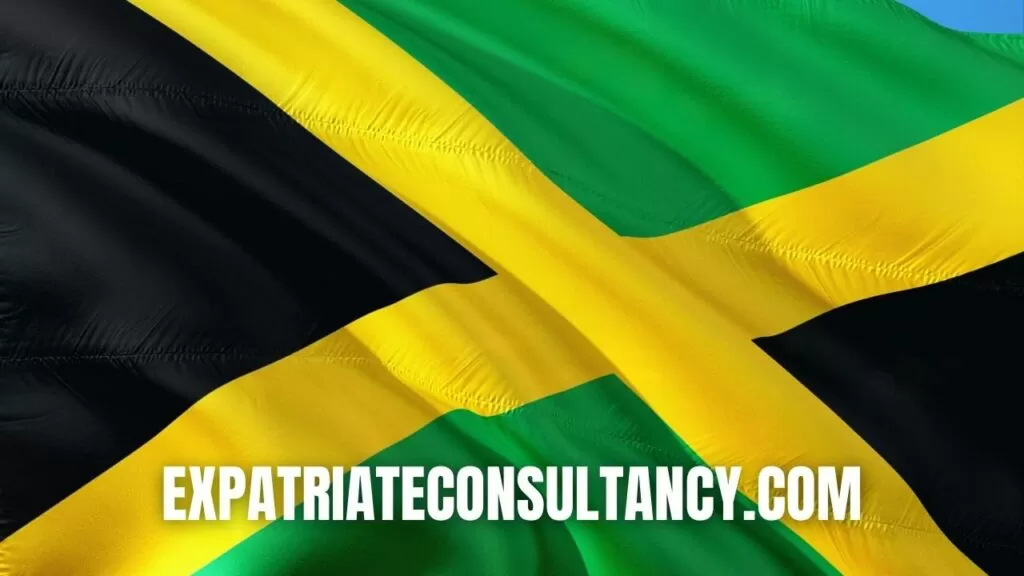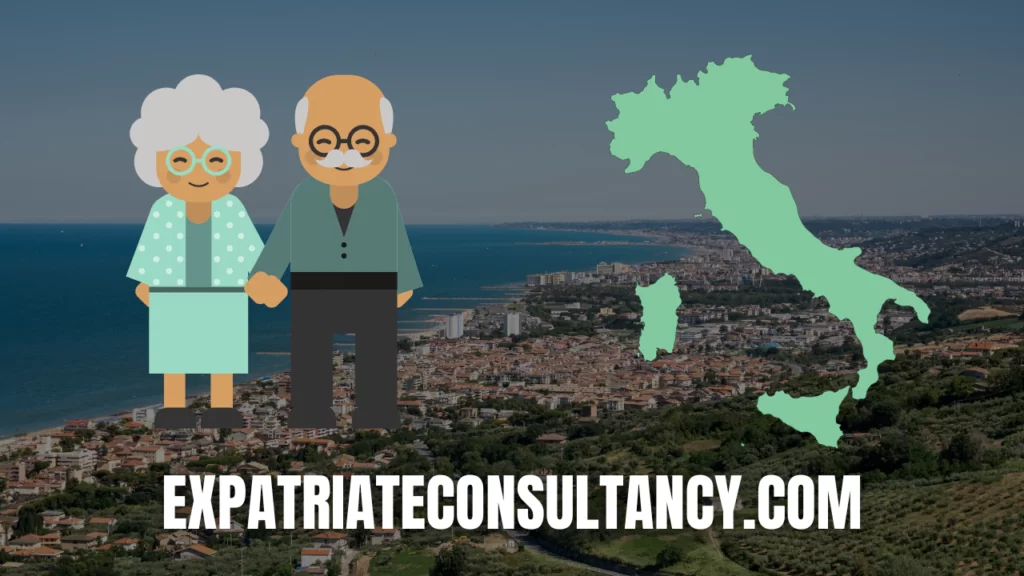Your monthly car payment back home in the US, UK, Canada, or Australia costs more than the price to retire in Colombia.
I helped hundreds of expats choose their place in South America, and this country still surprises me – for many reasons.
For example, in one of these 7 Colombian cities, you can live 72% cheaper than the average US cost of living, while accessing healthcare that outranks most American cities.
I’m talking about cities where a three-course restaurant meal costs $7, monthly rent for a modern apartment is $350, and your total monthly expenses, including entertainment, food, and utilities, come to less than most Americans pay for rent alone.
Places where locals joke that foreigners always double-check restaurant bills because they can’t believe how cheap everything is.
But the most impressive thing of all?
These
are
not
small villages
These are vibrant, modern cities with all the amenities you need for an incredibly comfortable life.
By the end of this article, this ranking of Colombia’s best places to live will completely transform your perception of what’s possible.
The Secret Formula Behind These 7 Colombian Cities
The real secret lies in six specific factors that most people completely ignore when choosing their new destination.
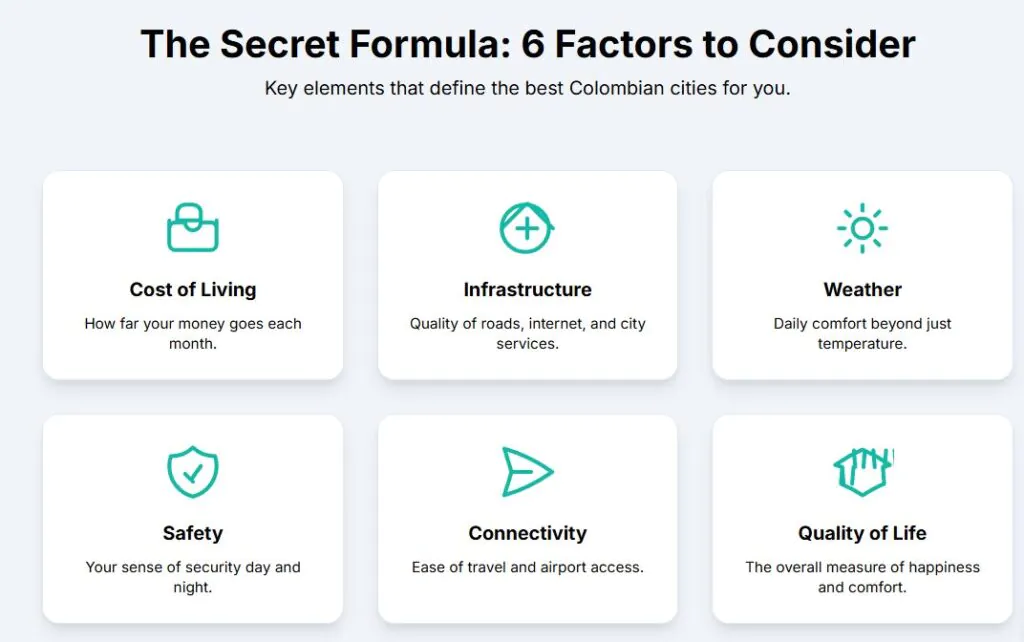
First, the cost of living measures how much your monthly budget stretches
Second, infrastructure and healthcare evaluate roads, internet speed, healthcare quality, and basic city services.
Third, weather determines your daily comfort, and even if you enjoy warm weather, the humidity is a completely different beast.
Fourth, safety measures crime rates and how secure you feel walking at night. As a South American myself, the first thing people ask me about my continent is if it is safe, and I always reply that it depends. So this factor will answer your questions.
Fifth, connectivity examines airport access and transportation links- and many Colombian cities have quick connections to the US and Europe.
And the Sixth factor, quality of life – which is self-explanatory.
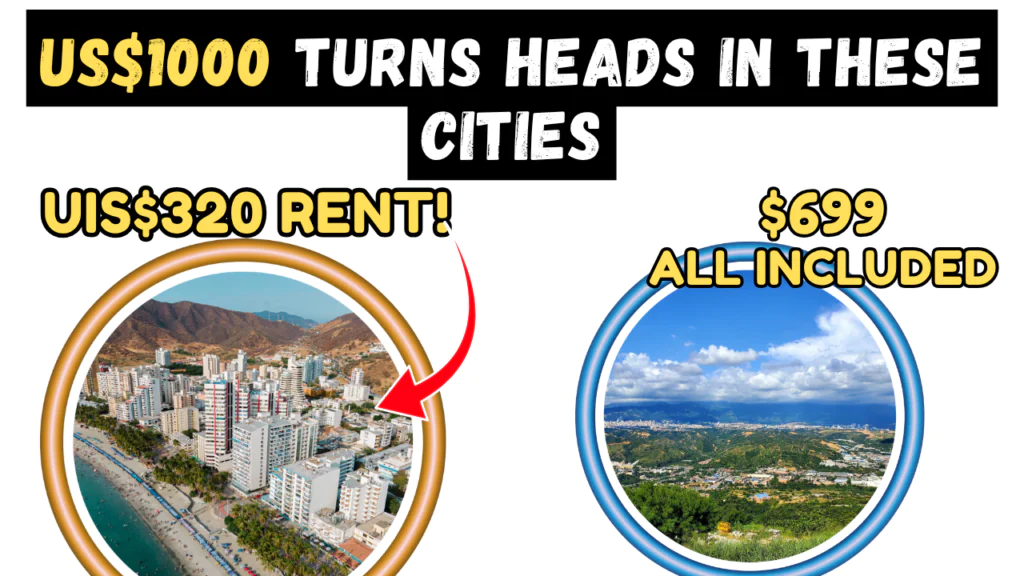
So let’s start with…
7th – Santa Marta
While tourists flock to expensive Cartagena, smart expats discovered this Caribbean gem that costs $900 less per month. Santa Marta sits between the Caribbean Sea and the Sierra Nevada mountains, giving you beach life and mountain adventures in one location. You can wake up to ocean views and drive to mountain coffee farms in under two hours.
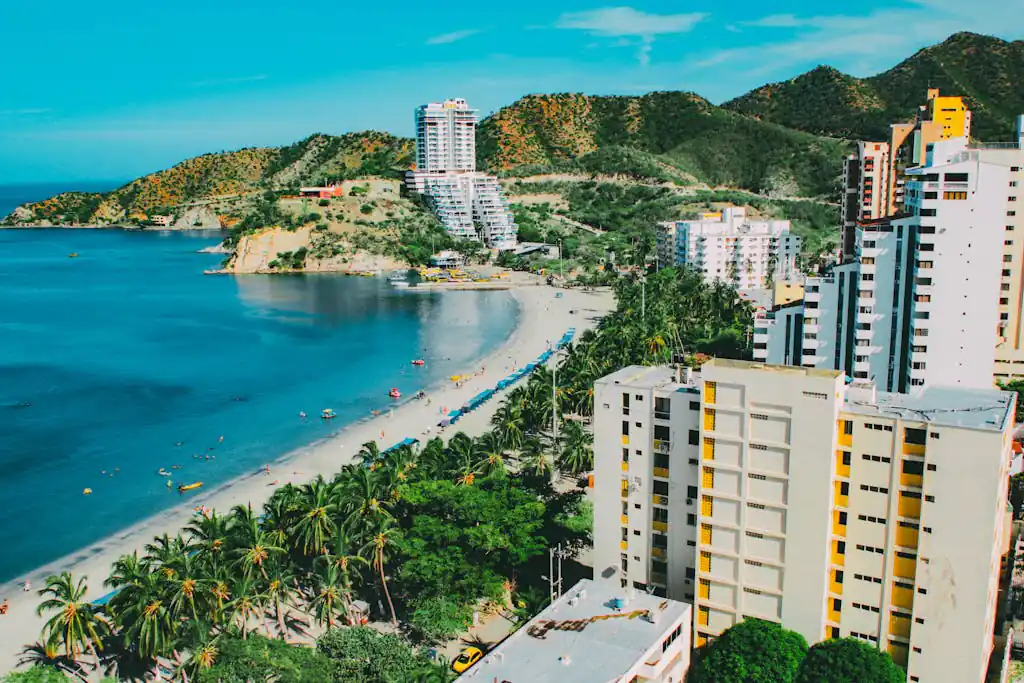
This city offers the authentic Caribbean experience that Cartagena lost to tourism. The vendors speak Spanish, not English. Restaurant menus show local prices, not tourist markup. You eat where locals eat, not where cruise ships dock.
A single person can live well there for about $826 per month. This costs 16% less than living in Bogotá.
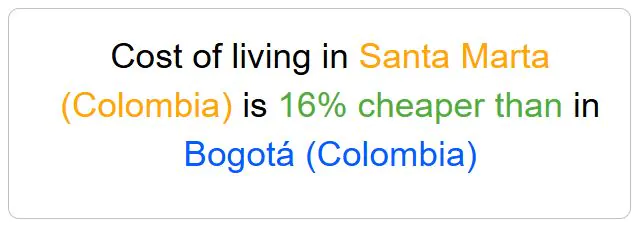
Here’s how your money breaks down each month: $225 for rent in a downtown one-bedroom apartment, $77 for utilities like electricity and water, $250 for food, $31 for getting around town, and $154 for fun and eating out. The beaches are clean and beautiful. The seafood tastes great and doesn’t cost much. You can visit Tayrona National Park on weekends without spending too much money.
However, Santa Marta has its drawbacks.
The internet infrastructure lags behind other Colombian cities, making remote work challenging during peak hours. Average internet speed hits just 7 Mbps, which struggles with video calls and large file uploads.
Safety requires street smarts, as petty theft is common, especially in tourist areas and isolated beaches. Crowd-sourced data rates day-to-day safety as “Bad,” with a “Very bad” score for crime levels. Violent crime dropped over 30% in recent years, but robbery and petty theft remain common.

The Caribbean climate brings hot, humid conditions year-round. This tropical weather attracts beach lovers but increases utility costs due to constant air conditioning needs.
This is what an expat living in Santa Marta told us about the weather:
“Since I arrived in early February it has been sunny nearly every day and only rained a few times. When I start missing cooler weather, I just take a bus 1 hour to Minca which is in the higher altitude rainforest at 610 m (2,000 feet).”
Simón Bolívar International Airport provides solid domestic connections to major Colombian cities, but international travel gets complicated. Direct flights to the US operate seasonally or through charter airlines. Most reliable international travel requires connecting through Bogotá, adding time and cost to your trips.
And since we are talking about Latin America and Caribbean, tell me in the comment section which other country in this region you would like me to cover in a next article! It is a pleasure to talk about the continent where I came from.
6th– Cartagena

Cartagena has old walls and colorful streets that look romantic and pretty. This UNESCO World Heritage site has 16th-century buildings. Stone forts protect the Caribbean coast while horse-drawn carriages move through cobblestone streets. The streets have balconies covered in bright flowers.
But expats pay high prices there for a good reason. There’s a strong international community. The expat network is well-built, with English-speaking doctors, international schools, and business connections that took years to create. You’ll find American-style drug stores, European restaurants, and cultural events that mix Colombian culture with what foreigners expect.
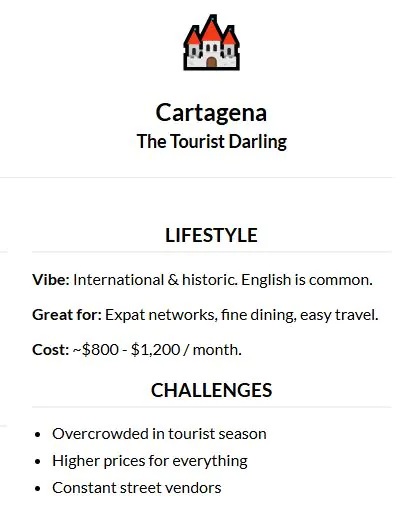
A single person needs $800 to $1,200 per month. This makes it one of Colombia’s most expensive cities. Rent costs the most. Most one-bedroom apartments in the city center cost $600 to $850 per month. Studios can start as low as $320 but range up to $960 depending on location. Living under $1,000 requires moving outside tourist zones, trading convenience for affordability. Even groceries cost more there than other Colombian cities due to tourism demand.
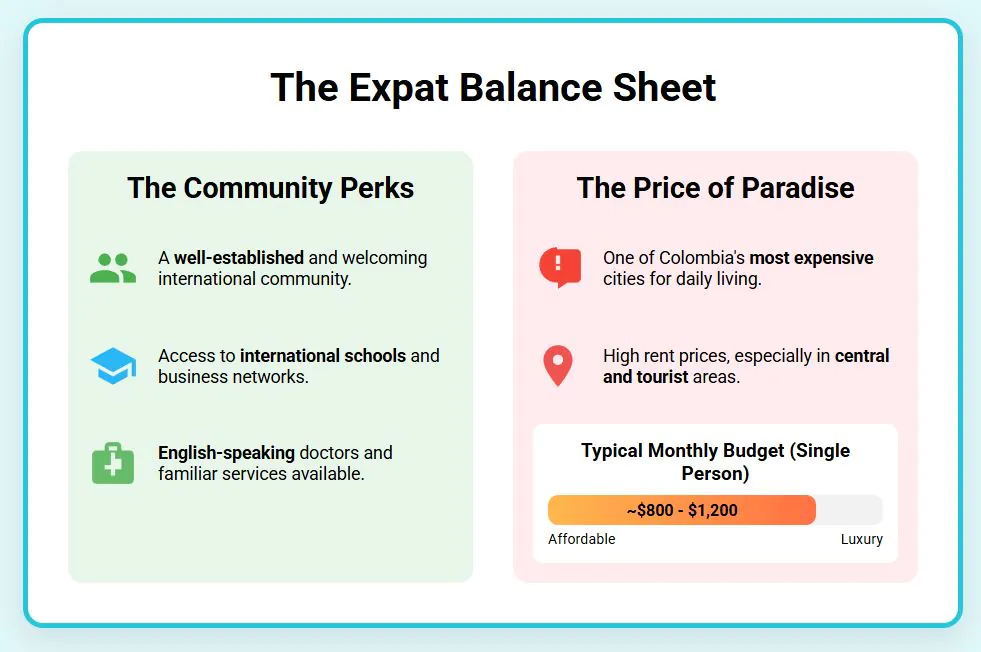
Cartagena’s infrastructure works well for international visitors. They have tourist police, medical services with English speakers, and things that feel familiar. Rafael Núñez International Airport has direct flights to Miami, Fort Lauderdale, New York, Canada, and Amsterdam. For healthcare, there’s Centro Hospitalario Serena Del Mar, ranked #24 in the country. The staff speaks English and knows how to work with international insurance. In addition to its excellent healthcare and travel connections, Cartagena is celebrated for its vibrant culture and rich history, making it one of the top destinations for Spanish speakers. Visitors can immerse themselves in the city’s stunning colonial architecture, picturesque beaches, and lively festivals. With an array of activities and experiences, Cartagena continues to attract travelers from around the world, enhancing its reputation as a must-visit locale.
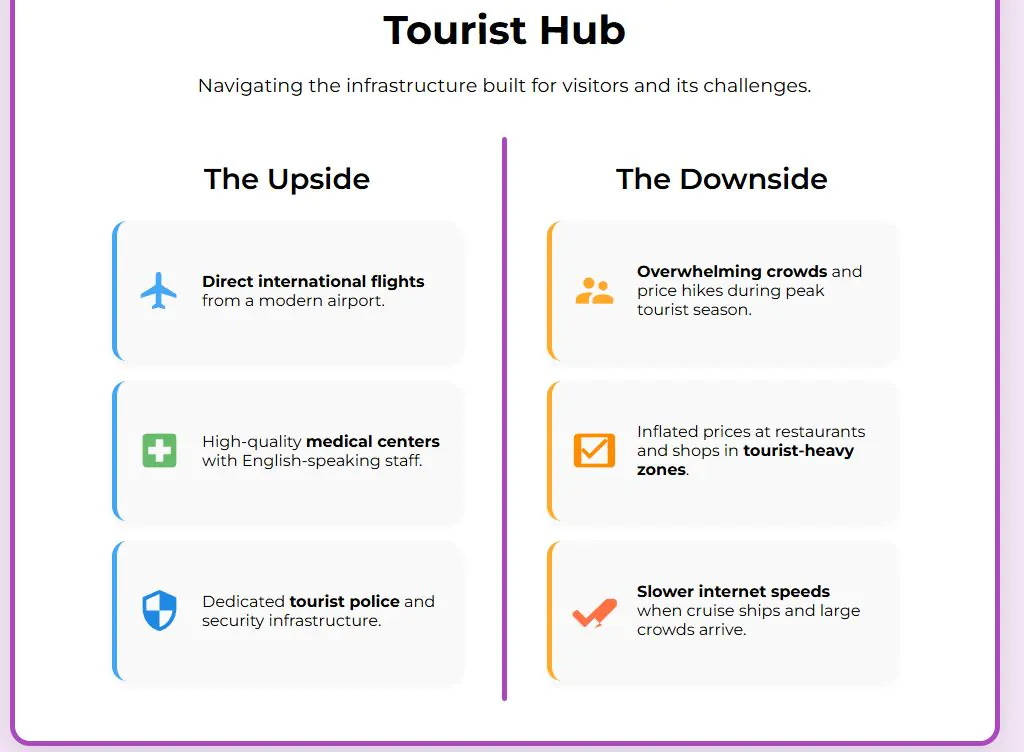
However, the focus on tourism creates distinct problems. During peak cruise season, crowds and prices spike—restaurants and transport get costlier and internet slows to around 8 Mbps. What feels charming in low season becomes overwhelming when tourist crowds arrive. Street vendors target anyone who looks foreign, and restaurants in tourist zones often charge double what locals pay.
This is what a Canadian living in Cartagena told us:
“If you are white you will be a constant target for peddlers and never seen as a true local. It is extremely hot and humid, which I found hard to live with. But I speak as a canadian so take it for what it is.”
5th – Armenia
This Coffee Triangle city is great for remote workers. It has what you need without the craziness of a big city. Armenia gives you small-town peace and modern services.
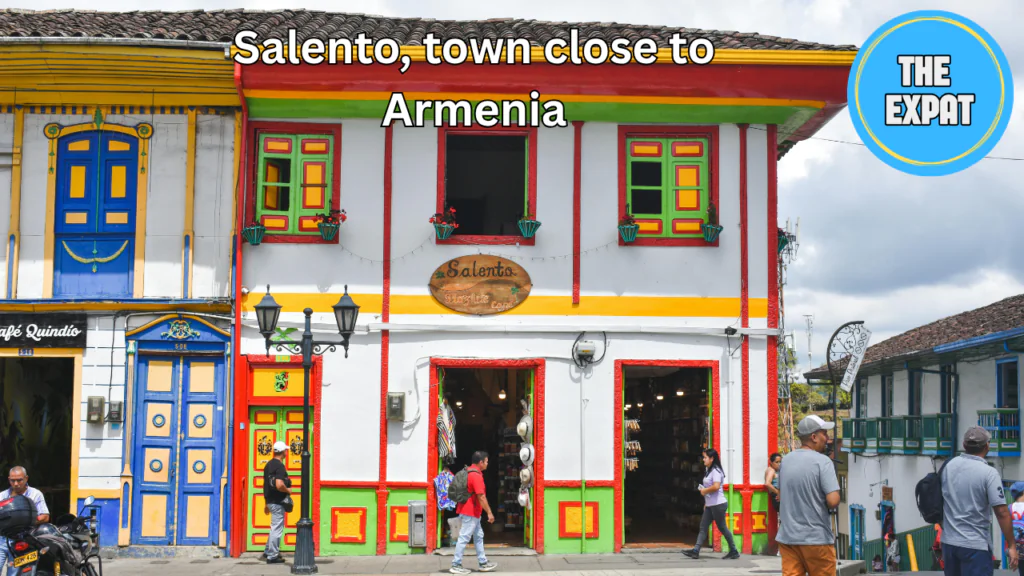
You can walk through quiet neighborhoods where coffee shops serve beans grown on nearby mountains. Your internet works better than most major cities around the world. Armenia beats other big Colombian cities because it has the fastest average internet speed in the whole country. A 2024 report revealed an impressive average download speed of 206.79 Mbps. Remote workers who struggled with connectivity issues elsewhere find Armenia solves their biggest problem instantly.
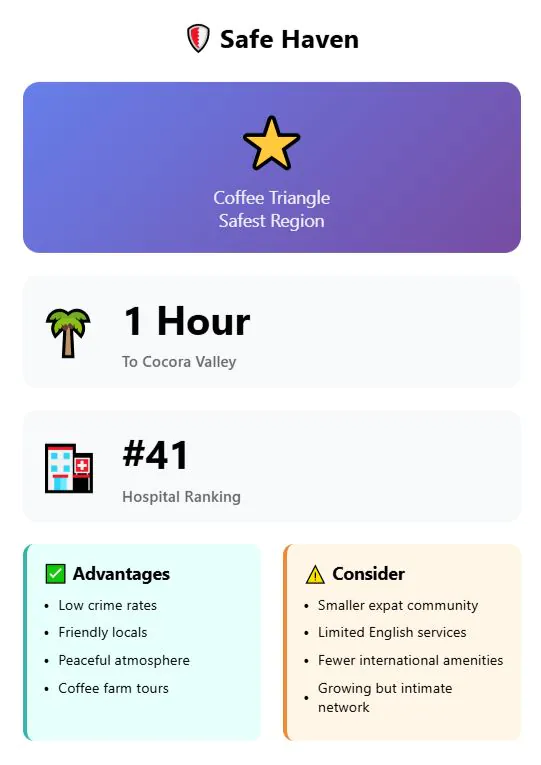
The city sits in the heart of coffee country, surrounded by lush green mountains and perfect spring-like weather year-round. This temperate climate lets you enjoy outdoor activities every day while keeping utility bills low.
A single person lives very comfortably there for around $747 monthly, with the most frugal budgets managing on $600-700. Your monthly budget stretches incredibly far in the Coffee Triangle, running 10-15% lower than Medellín costs.
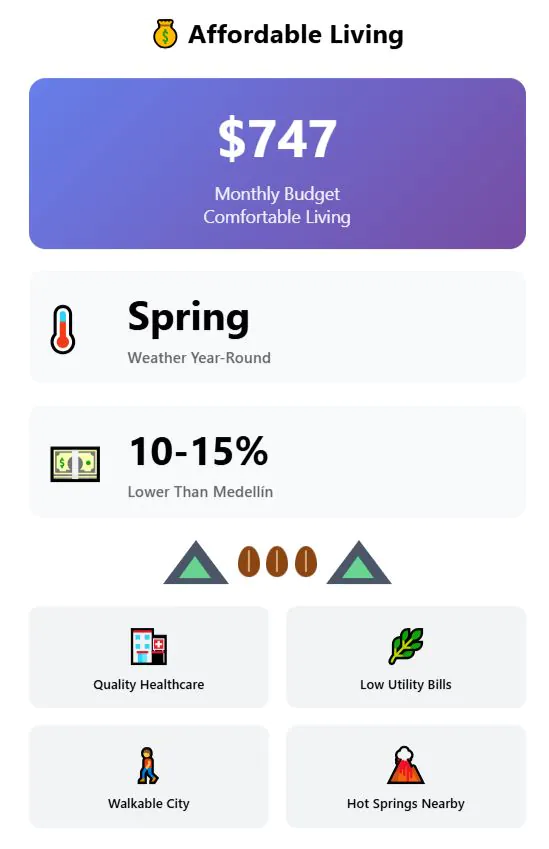
Healthcare access comes through Hospital Departamental Universitario del Quindío San Juan de Dios, ranked #41 in the country, providing solid local medical care for retirees and expats. Armenia’s location provides easy access to coffee farm tours, thermal hot springs, and some of Colombia’s most beautiful landscapes. The famous Cocora Valley with its towering palm trees sits just an hour away.
The Coffee Triangle region is generally considered one of Colombia’s safest areas, with low crime rates and friendly locals. This peaceful atmosphere creates a stress-free environment where you can walk safely and focus on work or relaxation.

However, Armenia’s small size means fewer international amenities and a smaller expat community than major cities. You won’t find the extensive English-speaking services available in larger cities. The expat network exists but remains intimate and growing.
Before we jump to the 4th place, I have some really good news. FREE FOR A LIMITED TIME: Grab your Expat Wealth & Lifestyle Compass ($108 value) today! Includes our 74-page guide of Affordable European Cities, our Zero-Tax countries report, and our expat checklist. https://bit.ly/ExpatWealthLifestyleCompass Join us here before this offer ends.
4th – Manizales
This is one of the few cities that locals described as safe for us. This is one of the residents said:
“Manizales is safe – you generally only see students walking around in the most public places, you don’t live in constant fear. There’s a strong police presence too.”
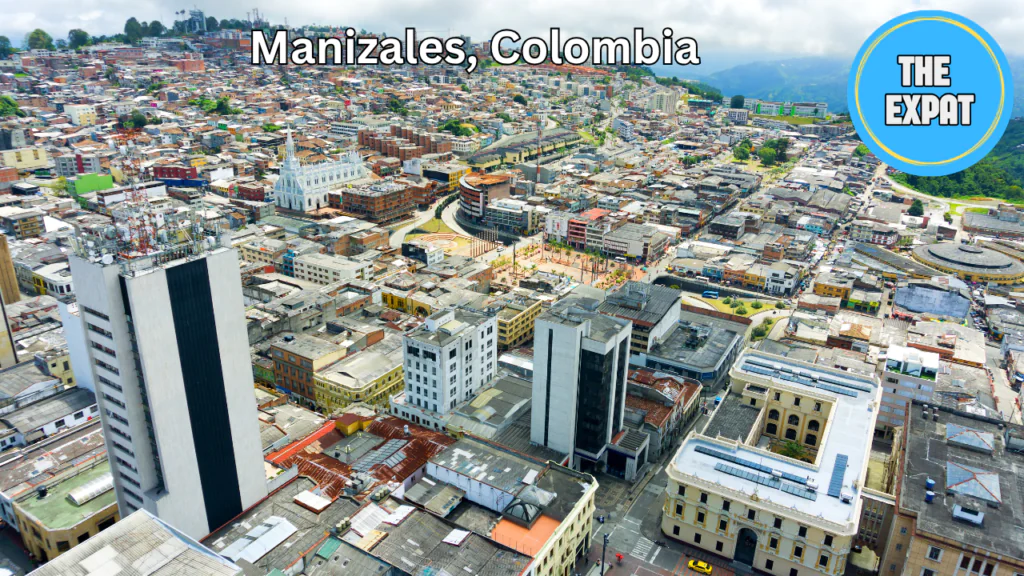
And it makes sense – Manizales is notable for its unique university atmosphere, which helps create genuine friendships with locals who want to practice English. Students from Universidad Nacional de Colombia and Universidad de Caldas actively seek conversation partners, creating natural opportunities for meaningful connections. You’ll find yourself invited to study groups, cultural events, and weekend trips with Colombian friends.

This academic presence transforms what could be another sleepy mountain town into a vibrant hub of ideas and innovation. Universities host free lectures, concerts, and art exhibits, enriching daily life. Book clubs meet in coffee shops, film festivals showcase Latin American cinema, and theater groups perform experimental works.
Additionally, the local ‘paisa’ culture is famously warm and welcoming. Manizales earned the nickname “La Ciudad de las Puertas Abiertas” (The City of Open Doors) because residents genuinely embrace foreigners. Neighbors invite you to family barbecues, and shopkeepers remember your name after a few visits.
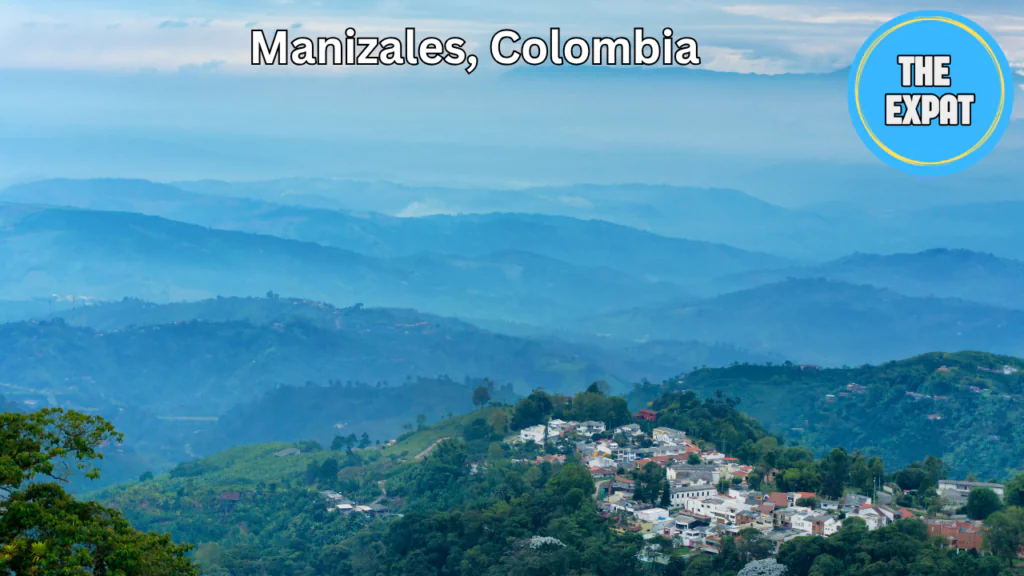
A single person lives comfortably on $700 to $1,000 monthly, with the university presence keeping costs reasonable. Student demand creates affordable housing options, budget-friendly restaurants, and competitive service prices. Your monthly budget covers a nice apartment for $385, groceries for $180, utilities for $70, and entertainment for $150. University areas offer cheap meals, affordable gyms, and cultural activities that cost almost nothing.
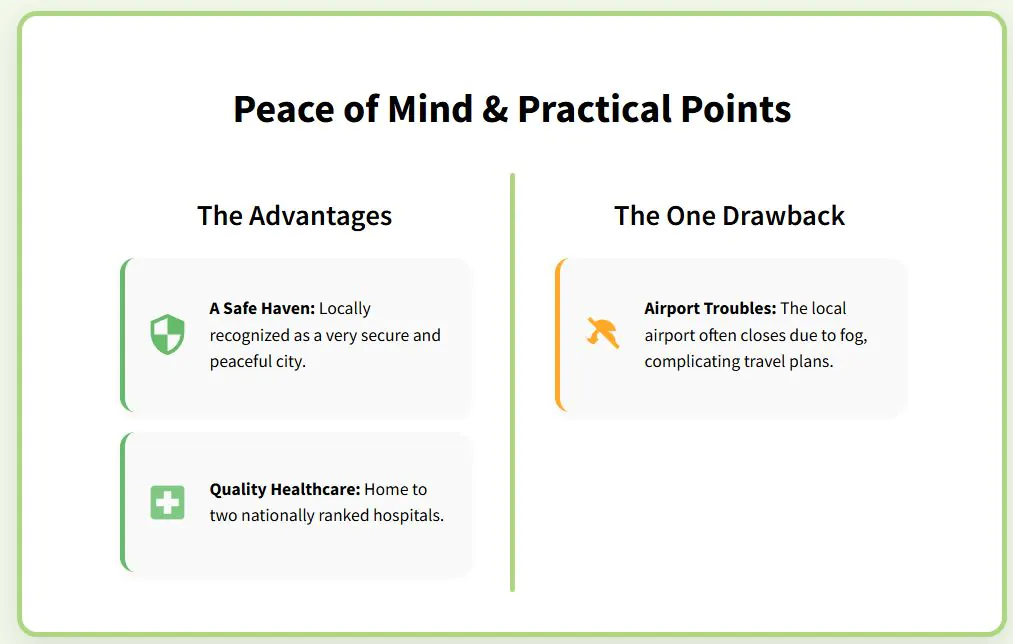
Manizales sits on mountainous terrain with stunning views and pleasant weather that locals call ‘eternal spring.’ The cooler version of this climate offers comfortable daytime temperatures without oppressive heat or humidity. The city’s unique public cable car system helps residents navigate the steep terrain, making transportation both practical and scenic.
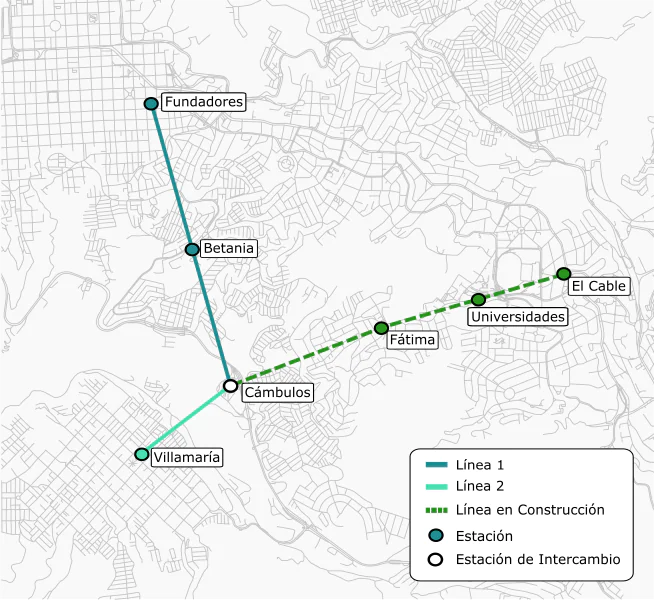
Healthcare access comes through two nationally ranked hospitals – Servicios Especiales de Salud Hospital Universitario de Caldas at #22 and Hospital Departamental Universitario Santa Sofía de Caldas at #36, providing above-average medical care for residents.
However, Manizales has one significant drawback that affects travel-loving expats. Airport connectivity is limited, with La Nubia Airport suffering frequent weather-related closures due to fog, forcing travelers to seek alternatives for reliable departures.
3rd – Pereira
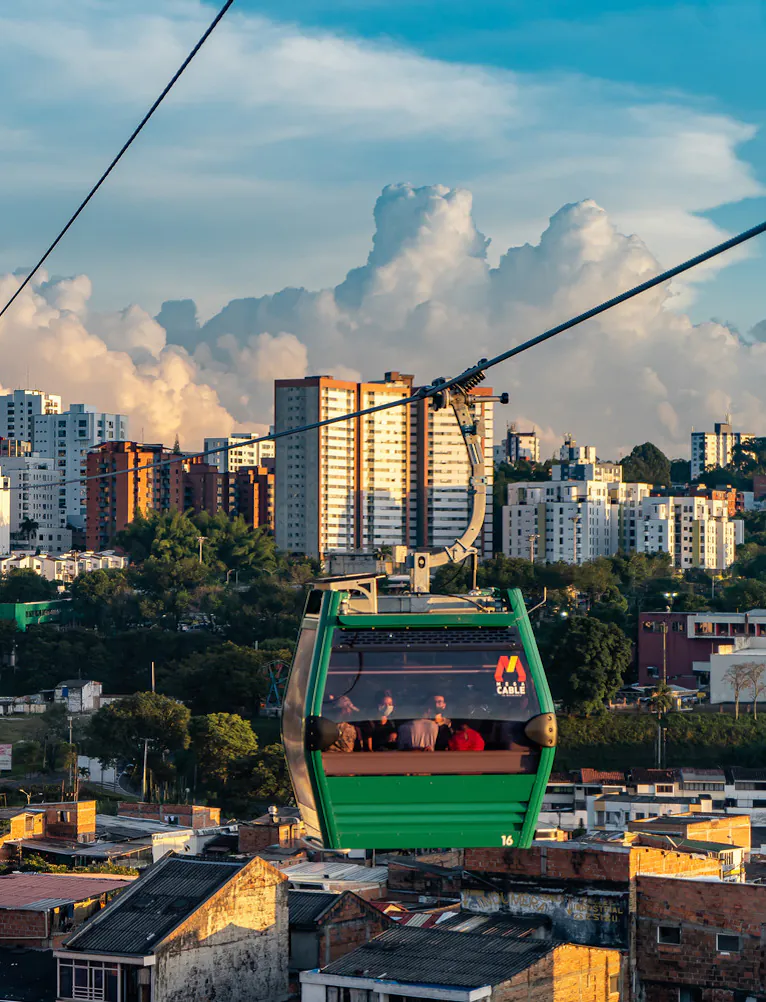
For expats concerned about travel, Pereira offers some of Colombia’s most convenient airport connections. Matecaña International Airport offers direct international flights to Miami, New York, and Panama City, eliminating the frustrating connections that plague travelers from neighboring cities. You can book a direct flight to Miami and be there in three hours instead of spending entire days traveling through Bogotá.
The city balances small-town affordability with big-city convenience. Its population of 500,000 is large enough for shopping centers, diverse restaurants, and urban amenities, yet small enough to avoid major traffic and stress.
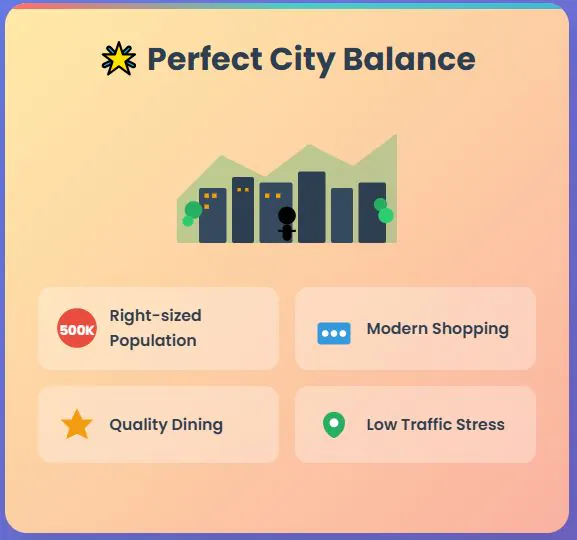
A local told us this:
“I left Medellin for Pereira and really enjoyed it – lots of cafes and bars and restaurants. Stay in Pinares, nice neighbourhood. Plus you have Cocora Valley nearby too.”
The direct flights, plus the efficient Megabús rapid transit system, offer seamless mobility. Weekend trips to the United States become realistic. Business travel doesn’t require planning around complicated connections. Family visits happen more frequently when flights are simple and direct.
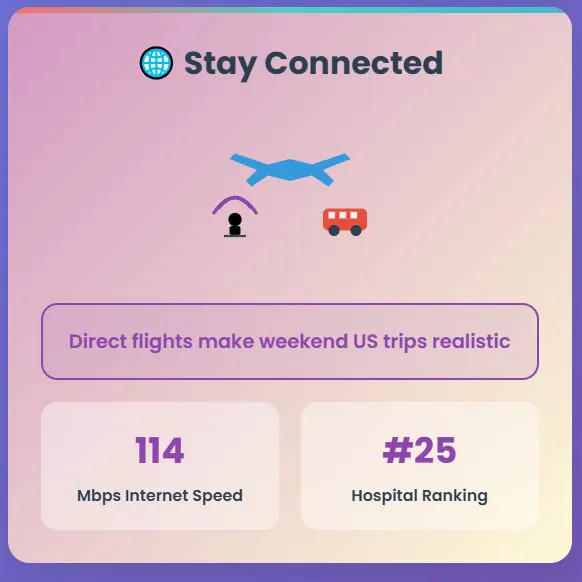
A single person lives comfortably on around $841 monthly while enjoying modern amenities and natural beauty. Your budget stretches incredibly far there – rent for a decent apartment in a good neighborhood starts around $256, while upscale units with amenities cost approximately $512. While couples may spend up to $1,300, singles find their money goes much further in this Coffee Triangle capital.
Internet speeds average 114 Mbps, making remote work completely viable. Healthcare ranks high with E.S.E Hospital Universitario San Jorge de Pereira earning the #25 spot nationally according to Newsweek’s 2024 rankings, providing reassurance on quality care for residents and expats alike.
There, you can access modern shopping and dining while still being surrounded by the coffee farms and pleasant climate the region is famous for. You never feel isolated from urban amenities.
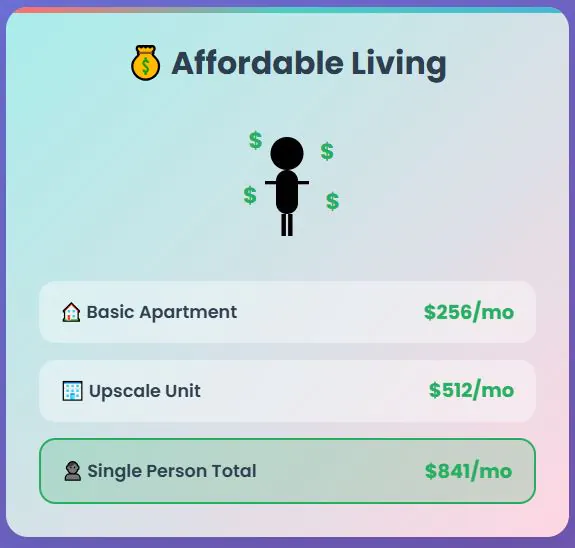
The expat community is growing but remains small enough that newcomers quickly become part of the local social fabric. Popular neighborhoods like Pinares and Circunvalar provide comfortable, social environments where expats connect easily. The community stays active without becoming overwhelming or cliquish.
Pereira’s balance of affordability, connectivity, and quality of life makes it an excellent choice for expats.

2nd – Bucaramanga
They call it ‘La Ciudad Bonita’ (The Beautiful City), but its main draw for expats is a high quality of life on a budget of $600-700 monthly. Bucaramanga offers safety, healthcare, and modern infrastructure without premium prices.
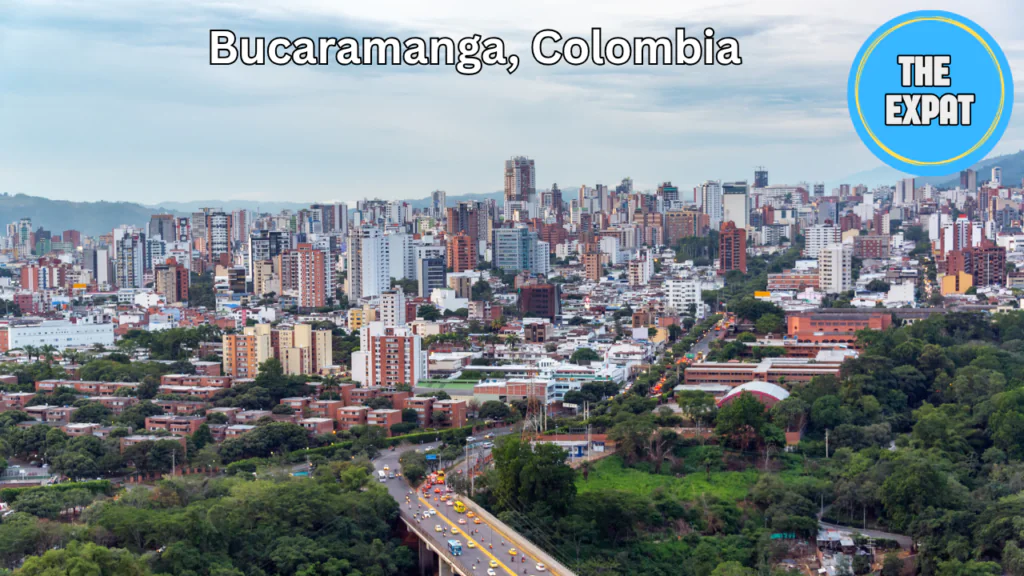
While often overlooked, the city provides excellent amenities at low prices, a result of decades of careful urban planning and community pride that shows in every clean street and well-maintained park. You get organized infrastructure, efficient public transportation through the Metrolínea system, and reliable internet averaging 110 Mbps.
A single person lives very comfortably, with a total monthly budget potentially falling in the $600-700 range. Research shows a single person’s total monthly cost, excluding rent, can be as low as $310, with rent at $278, illustrating the true bottom-line affordability. Dining out costs practically nothing – a meal at an inexpensive restaurant averages just $3.61.
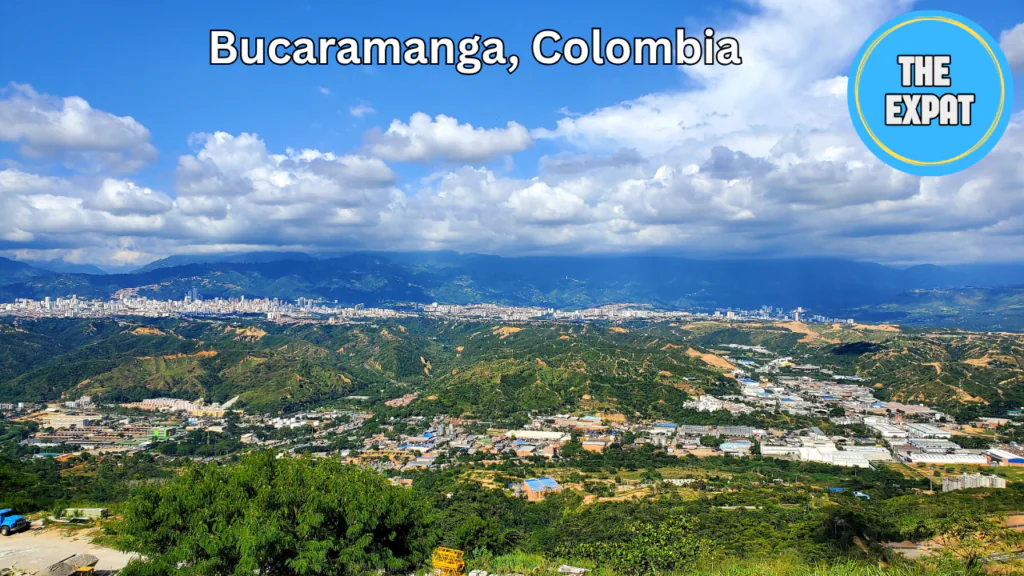
The city is widely regarded as one of Colombia’s safest, with clean streets, organized infrastructure, and low crime rates. Expats choose neighborhoods like Cabecera, Sotomayor, and El Prado for their high level of safety and amenities. The calm demeanor of residents creates a secure environment where you can walk confidently.
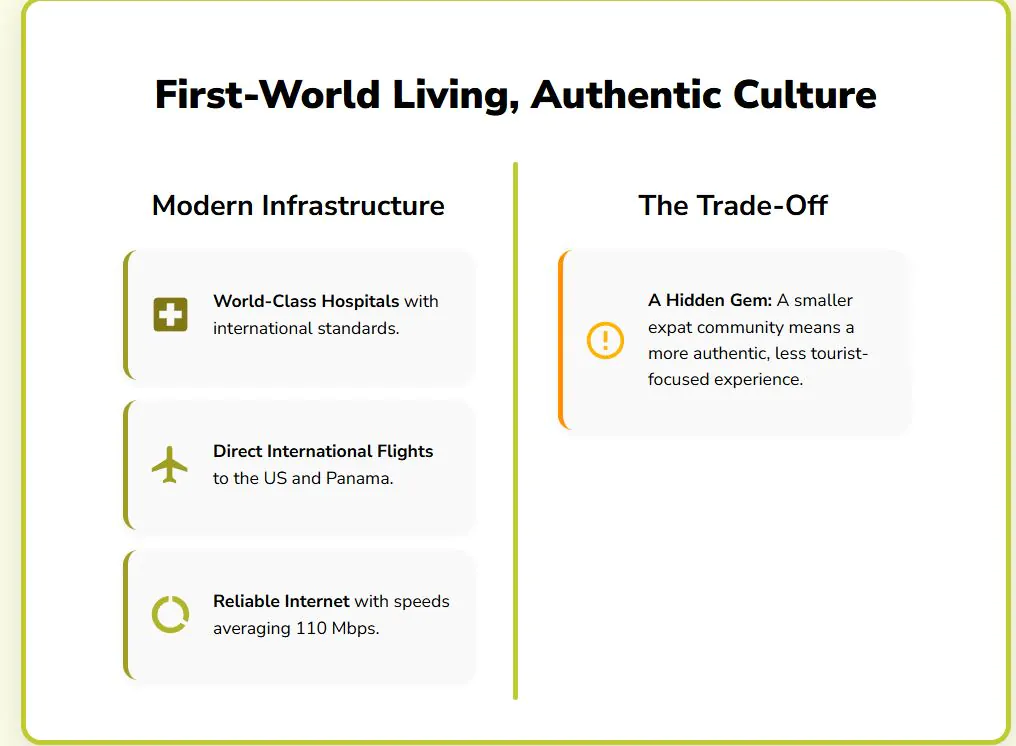
Bucaramanga’s healthcare system features world-class facilities. The Hospital Internacional de Colombia and its Cardiovascular Institute provide medical care that matches international standards. This access to quality healthcare is a significant benefit for expats, especially retirees.
The pleasant year-round climate, with temperatures between 68°F and 82°F, keeps utility costs low. Palonegro International Airport offers direct flights to Fort Lauderdale, Miami, and Panama City, solving connectivity concerns while maintaining affordability.
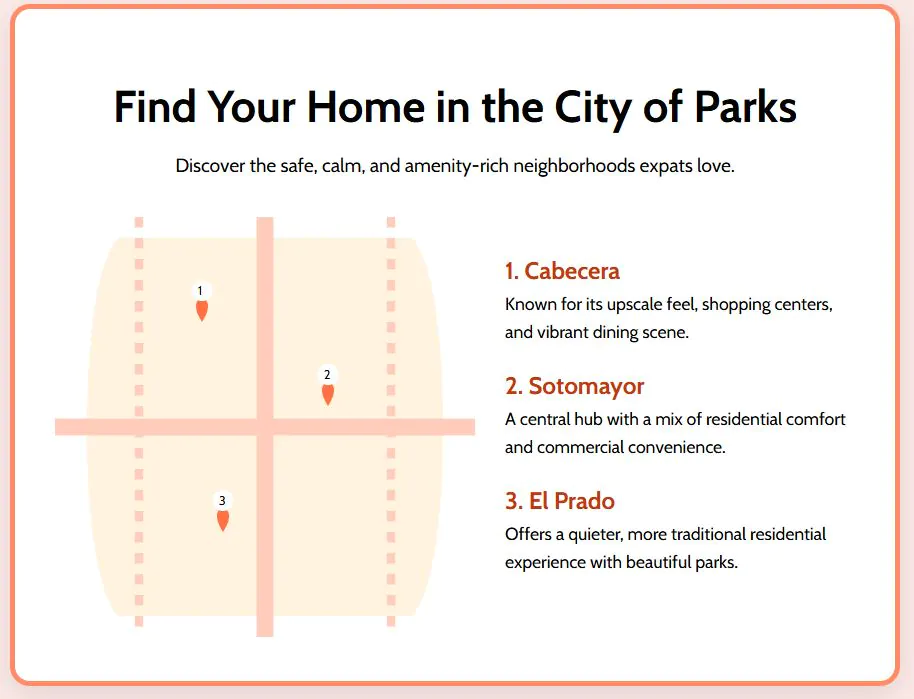
A local described the city to us in very nice terms:
“I think Bucaramanga is a great city! It’s safe, clean, it has nice weather, tons of parks, it also has the most consolidated middle class in the whole country, good food and the city keeps growing – I see a great future for that place.”
However, Bucaramanga’s perfection comes with one trade-off—it’s not as internationally known. This means a smaller expat community, but also that you’ll experience authentic Colombian culture without tourist inflation.
1st – Medellín: The Best City to Live in Colombia
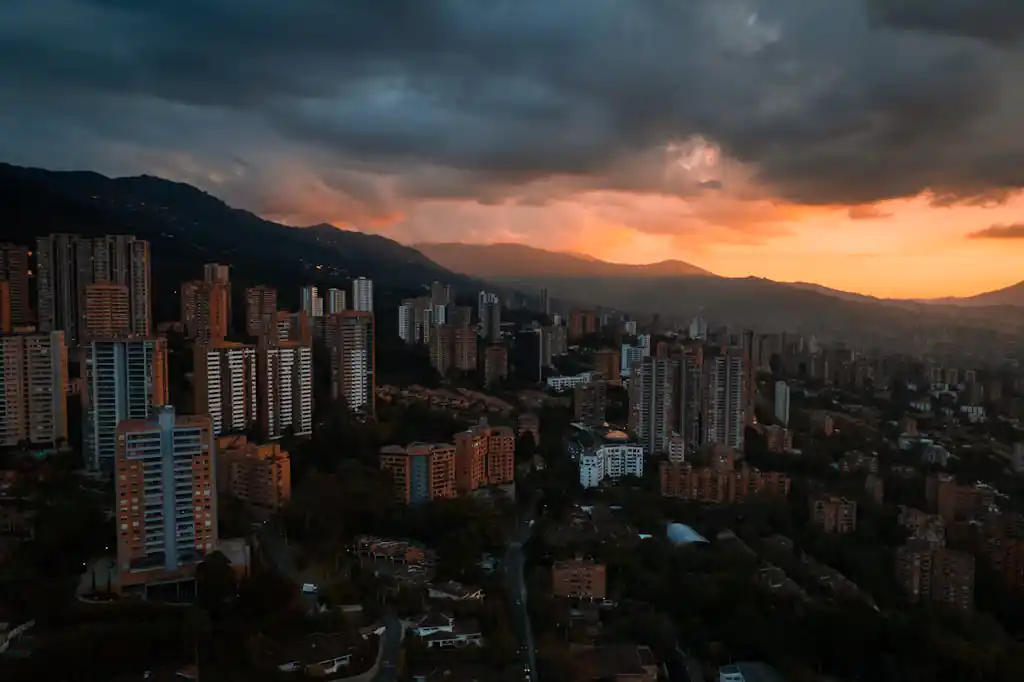
Many expats find Medellín’s unmatched urban experience justifies the higher cost. The city changed from a violent place to a lively, world-class center. This amazing change earned it the title of “Most Innovative City.” Now it attracts expats and digital nomads who love its energy and new ideas.

People go there for its modern services and great weather. The city has a modern Metro system – the only one in Colombia. It also has cable cars that connect the valley to hillside neighborhoods.
Also it is a very green city, like a resident described to us:
“The city is gorgeous in some areas, and run down in others like most places in the world. You’re surrounded by beautiful mountains, and plants and tree are everywhere – the city is VERY VERY green and its tranquil. I love the scenery to be honest.”
A basic expat budget starts around $1,095. Comfortable living costs $1,200-1,800 per month. This makes it more expensive than other places but still very cheap compared to Western prices. Living outside popular expat areas like El Poblado and Laureles costs less. Spending more lets you live in the best locations.
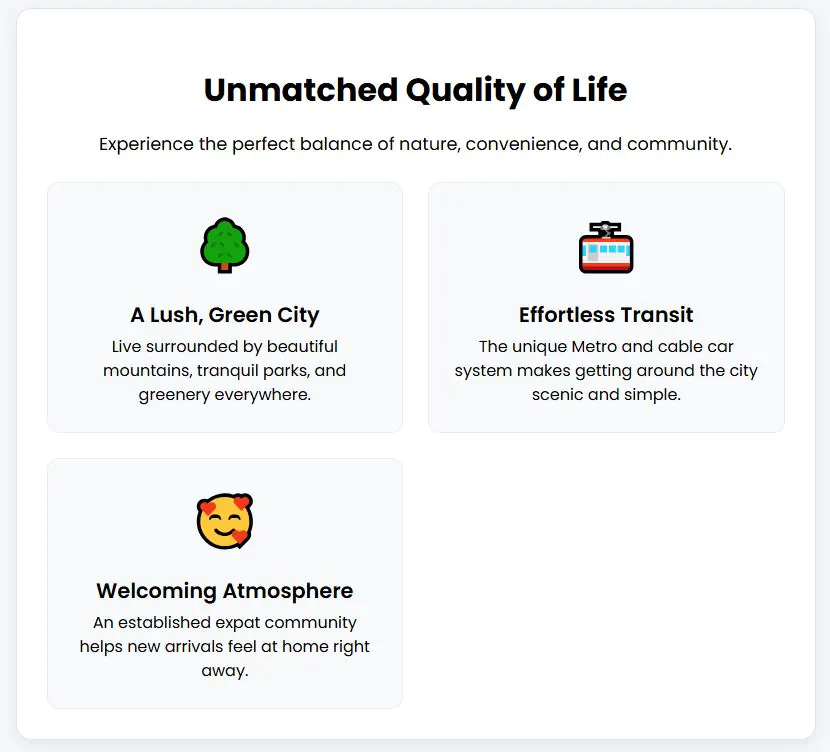
The weather stays like eternal spring. Temperatures stay around 72.5°F (22.5°C) all year. You don’t need heating or air conditioning. The city has a world-class metro system, modern hospitals, and a strong business area that matches any major international city. Hospital Pablo Tobón Uribe ranks #3 in the country and Hospital Universitario San Vicente Fundación ranks #6. There are other top-ranked hospitals too..This access to quality healthcare offers a key reassurance for expats.
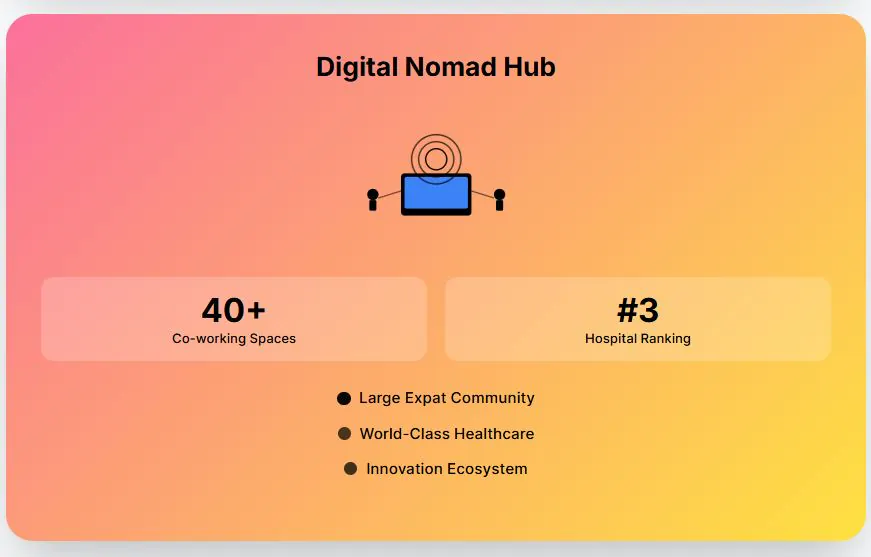
The large expat community provides English-speaking services, international restaurants, and familiar amenities that ease the transition, offering a strong support system that reduces the potential for isolation.
Innovation hubs and digital nomad communities make Medellín perfect for remote workers and entrepreneurs. There are over 40 co-working spaces catering to this demographic, fostering creativity and collaboration.
Now, Colombia is not the only good place in the world where you can live on US$1000 or less. Discover here 4 really nice countries to live on US$1000 or less.
Levi Borba is the founder of expatriateconsultancy.com, creator of the channel The Expat, and best-selling author. You can find him on X here. Some of the links above might be affiliated links, meaning the author earns a small commission if you make a purchase.
